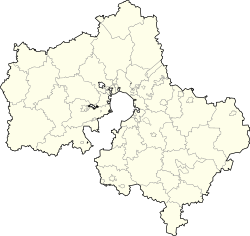Vereya, Naro-Fominsky District, Moscow Oblast
| Vereya (in English) Верея (Russian) |
|
|---|---|
| - Town - | |
 Kirovskaya Street in Vereya |
|
 Location of Moscow Oblast in Russia |
|
|
|
|
|
|
|
|
|
|
| Administrative status (as of September 2013) | |
| Country | Russia |
| Federal subject | Moscow Oblast |
| Administrative district | Naro-Fominsky District |
| Town | Vereya |
| Administrative center of | Town of Vereya |
| Municipal status (as of January 2013) | |
| Municipal district | Naro-Fominsky Municipal District |
| Urban settlement | Vereya Urban Settlement |
| Administrative center of | Vereya Urban Settlement |
| Statistics | |
| Population (2010 Census) | 5,368 inhabitants |
| Time zone | MSK (UTC+03:00) |
| First mentioned | 1371 |
| Postal code(s) | 143330 |
|
|
|
| on | |
Vereya (Russian: Вере́я) is a town in Naro-Fominsky District of Moscow Oblast, Russia, located on the right bank of the Protva River 113 kilometers (70 mi) southwest of Moscow. Population: 5,368 (2010 Census);4,957 (2002 Census);5,606 (1989 Census); 6,500 (1969).
It was first mentioned in a chronicle in 1371. During the following century, Vereya was the seat of the tiny Vereya Principality, ruled by a lateral branch of the Muscovite Rurikids. The last prince of Vereya was married to Sophia Palaiologina's Greek niece. He escaped to the Grand Duchy of Lithuania and married his daughter Sophia to Stanislovas Goštautas.
Within the framework of administrative divisions, it is, together with nineteen rural localities, incorporated within Naro-Fominsky District as the Town of Vereya. As a municipal division, the Town of Vereya is incorporated within Naro-Fominsky Municipal District as Vereya Urban Settlement.
The Nativity Cathedral in the local kremlin was commissioned by Vladimir of Staritsa to commemorate the conquest of Kazan in 1552. It was extensively rebuilt at the turn of the 18th century; a lofty Neoclassical belltower was erected in 1802. The oldest parish church goes back to 1667-1679.
...
Wikipedia



